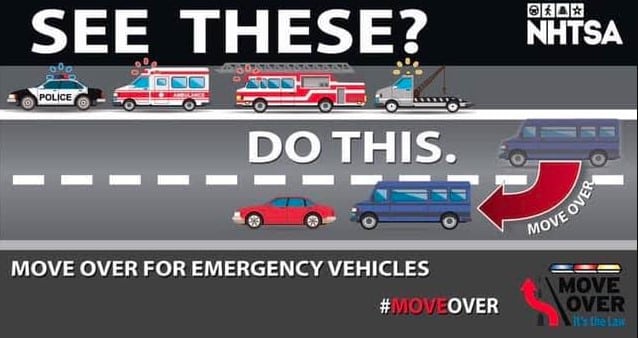What Is the Move Over Law?
Last updated Wednesday, April 16th, 2025

Every state besides the District of Columbia in the United States has some variation of the Move Over Law, which dictates that when approaching Law Enforcement, Emergency Vehicles and First Responders, cars should slow down, change lanes and “move over” whenever possible to give them room. Additionally, 48 states (excluding Louisiana and Wyoming) consider Tow Trucks to be First Responders. While the specific articles in each state’s law vary, the sentiment is the same across America.
Move Over For Emergency Vehicles Law – Common Sense for Saving Lives
It is up to each and every one of us to take initiative and discuss the importance of “Move Over” Laws and how they have saved the lives of countless first responders. You may have experienced the gnawing dread of approaching a traffic jam. Most drivers have uttered the words “What’s the hold up?” more times then they can count. In many cases, instead of the fiery car accident that you expected, it turns out that the delay was a single police car, lights flashing, pulled over to the side of the road.
This is it? You wonder. How are so many people such bad drivers?
Move Over Laws Protect First Responders
The answer is: The people who slowed down and moved over were following the law, and you should too.
If this sounds unfamiliar, you are not alone. According to a national poll by Mason Dixon Polling & Research, 71% of Americans have not heard of “Move Over” laws.1 In 2005, 390 emergency responders were killed after being struck by a negligent vehicle. That equated to almost 7% of emergency responder fatalities that year.2 Because of these numbers, states across America are taking greater strides to defend those working hard to protect civilians and save lives.
Move Over Laws by State: Kentucky, Indiana and Ohio
The rules vary slightly from state to state. While some states require vehicles to slow down an exact amount, such as 20 mph, other states leave it to the driver’s discretion. Kentucky and Ohio leave slowing down to the driver, as long as they maintain a safe speed for road and weather conditions. Indiana requires the driver of the vehicle to slow down by at least 10 mph lower than the posted speed limit. The following are important facets of the “Move Over” law to know about each of these three states. For complete details, visit MoveOverLaws.com.
Kentucky Move Over Law
Year Implemented: 2003
When approaching a stationary emergency vehicle, drivers should abide by the following standards: No operator of a vehicle should follow an emergency safety vehicle any closer than a proximity of 500 feet. When driving on a road with no fewer than two lanes going the same direction, switch lanes with due regard to safety and road conditions. Or, reduce speed in a way that is safe regarding road and weather conditions.
Ohio Move Over Law
Year Implemented: 2000
The move over law in Ohio states that when approaching a stationary emergency vehicle (including road service and waste collection vehicles), drivers should abide by the following standards: If the driver is not traveling on a road that allows them to move into another lane, the driver must reduce their speed and maintain a safe speed for the road and weather conditions. The speed reduction is largely left to the driver’s discretion.
Indiana Move Over Law IC Code
Year Implemented: 2002
When approaching a stationary emergency vehicle (including road maintenance vehicles, utility vehicles and municipal vehicles), drivers should yield right of way and abide by the following standards: The driver shall proceed with due caution and drive 10 mph slower than the posted speed limit. Drivers should also yield right of way by making a lane change on roads that are not less than two lanes going the same direction.
If the slight state-by-state law variations are starting to stress you out, take a deep breath. In many states, officers of the law take driving conditions into consideration when assessing drivers who are passing emergency vehicles. What’s most important is that you pay attention and safely approach emergency vehicles while driving.
“I did not know the “Move Over” law existed until I was pulled over myself,” says Darryl Isaacs. “I was returning to Louisville from Holiday World with my family and had no idea why I was pulled over, because I was driving the speed limit. The officer explained that I had failed to switch lanes when passing an emergency vehicle that had pulled over to the side of the road. Now, I always slow down and switch lanes to give first responders the space they need to stay safe.”
How the Move Over Law Movement Affects Drivers
Despite continued efforts to improve the safety of emergency and road personnel, tragedy strikes every year. In May 2019, an Indiana road maintenance professional was struck and killed by a big truck while conducting a roadside repair on a disabled box truck.3
The most important question to answer before you get behind the wheel again is this: What does your state’s move over law require you to do? Knowing how your state mandates these laws is the first step you can take to make the roads safer for yourself and for first responders operating emergency vehicles.
For more information about move over laws and accident prevention, contact our office today.
Isaacs & Isaacs, Primary Office
1601 Business Center Ct
Louisville, KY
40299
502-458-1000
Footnotes:
1. [MOVER OVER, AMERICA]↩
2. [Move Over Laws]↩
3. [Roadside repairman killed when semi crashes into disabled truck along I-74 near Lizton]↩










